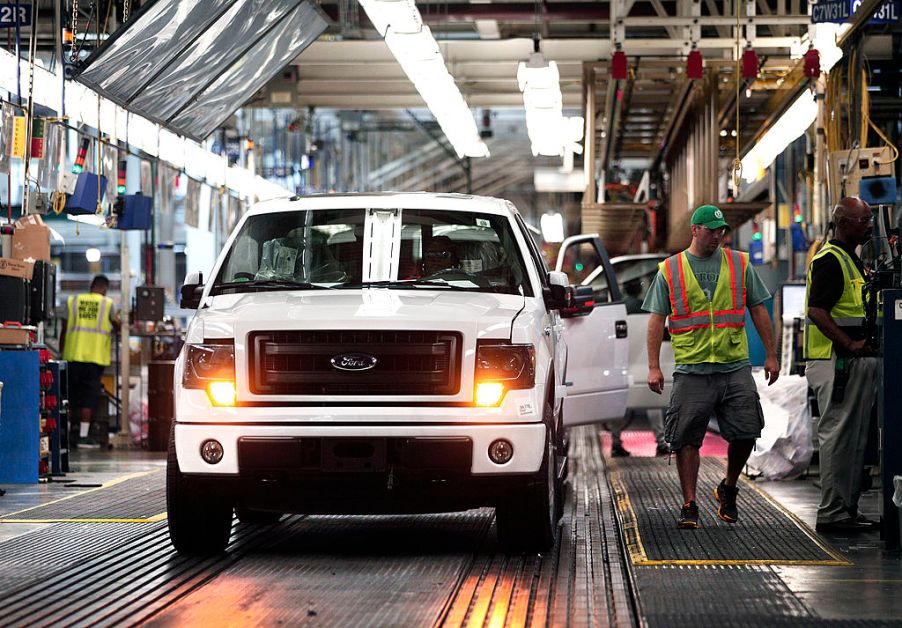
This Ford Truck Will Be a ‘Constant Headache’ to Anyone Who Buys It
Drivers expect modern vehicles to be reliable, whether in freezing winter or baking summer. Especially pickup trucks, which form a key part of both industry and daily living. New or used, they have to work. Although the Ram 1500 is closing in, part of the Ford F-150’s appeal is the perception of rugged dependability. Unfortunately, not every generation of F-150 fulfills that promise. The 2009-2014 12th generation is particularly troublesome. Out of 102 generations of Ford vehicles, Ford Problems has rated, the 12th-gen F-150 ranks 101st. Here’s why the 2009-2014 Ford F-150 will be a constant headache for any owner.
2009-2014 Ford F-150 Engine Problems
The 2011 F-150 may have debuted the turbocharged EcoBoost engine, but the 12th-gen F-150’s engines have been a particular trouble spot, according to Car Complaints.
2009 F-150 owners have repeatedly complained about strange noises coming from the engine. Some even said the gas engine would “clatter like a diesel at low RPM.”
The EcoBoost engine may have been a significant industry first, but it led to some major headaches. The 2012 model year is actually the worst year for the F-150, partially due to issues with that engine. Condensation could build up inside the intercooler and cause misfires. Ford did issue a technical service bulletin for the issue, but some dealerships never followed up on it. In addition, 2012 F-150 owners sometimes experienced a loss of power while driving.
Consumer Reports also ranked the 2011 model year poorly for its engine. Owners of these trucks have complained of timing chain issues, some of which were severe enough to warrant a completely new engine.
Finally, the 2010 model year ranks as a particular low-point for engine reliability. Owners reported leaky head gaskets, engine oil pan gaskets, as well as rough idle due to carbon build-up on the sensors. The spark plugs could also cause ignition coils to fail, causing misfires and even a total inability to start the engine.
2009-2014 Ford F-150 Window Problems
The third most common issue with the 12th-gen F-150 on Car Complaints is the 2010 model’s rear window. Owners would be driving along, and with a loud pop or bang, their rear window would shatter.
The NHTSA didn’t open an investigation on the issue, and Ford has never issued a recall for this problem. However, GlassBytes reports that Ford did issue two TSBs for the rear window. One for side panel water leakage, and another for problems with the rear-window defrost. Ford Authority reports that many 2010 F-150 owners whose rear windows shattered were running the defrost at the time. Once the window broke, several smelled “burning electronics.”
Transmission Woes
But the rear window issue is not the only reason why the 2010 F-150 ranks so poorly on Ford Problems. As both MotorBiscuit and Car Complaints report, the 2010 model year also had transmission problems.
According to owner reports on Car Complaints, the 2010 transmission would often shift very roughly or jerkily. One owner described the rough shifts as sounding like “a hammer hitting the floorboard.” At other times, the transmission would mistime shifts. It would upshift when the engine was just off idle, so the engine would stall. Or, it would downshift when slowing to a stop, and cause wheelspin.
Consumer Reports also ranks the 2010 F-150 poorly for both transmission and drivetrain issues. Owners reported the transmission would leak and slip, with many of the same comments as on Car Complaints. Some of the transmission complaints could have also been due to the problematic driveshafts and drive systems. The same “clunks” appear here in owner complaints, as well. Some were fixed by additional lubrication, others required completely new driveshafts.
Ford has clearly learned from these issues, as the latest F-150 was noted for excellent shifting.
2009-2014 Ford F-150 Additional Problems
The 2009-2014 model years also had several minor issues, Ford Problems reports.
The MyFord Touch system was particularly troublesome. It would fail to recognize phones, Sync would randomly freeze, and sometimes the screen would turn off for no reason. This feature was introduced in 2010 and is especially problematic for that model year.
Ford also switched to a different brake master cylinder for 2013. The new design let brake fluid leak back into the brake booster. Not only did this result in spongy brakes, it meant braking distances increased significantly. There was actually a recall for this master cylinder in 2013 and 2014, but Ford continued to use the design until 2018.
Finally, poorly-designed lug nuts. Or rather, cheaply-designed ones. A class-action lawsuit alleged that Ford had used steel-capped aluminum lug nuts instead of solid steel ones to cut costs. Unfortunately, the design trapped moisture and caused corrosion, and the lug nuts would even swell and delaminate when temperatures rose. So, if owners needed to change a tire, they found lug nuts either too big for their wrenches, or fused extremely tightly to the lugs. And because the swelling wasn’t uniform, it meant even roadside services like AAA had a hard time removing them. The lawsuit was dismissed, but the problem has cropped up on many F-150’s produced after 2010.


